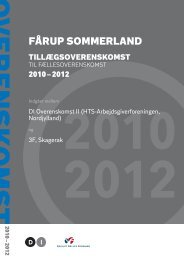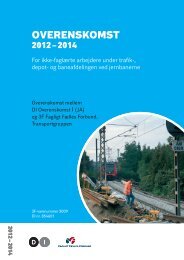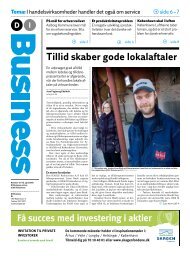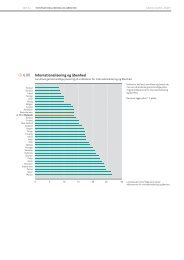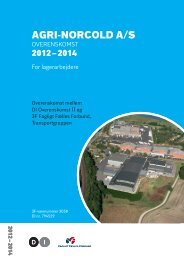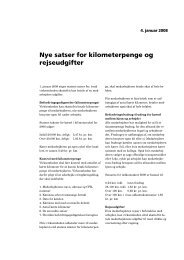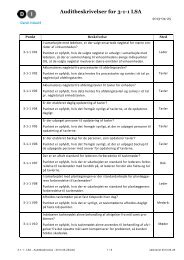6Risø Energy Report 3Summary, conclusions <strong>and</strong> recommendations2recently launched an extensive research <strong>and</strong> developmentstrategy to develop hydrogen vehicles <strong>and</strong> ahydrogen infrastructure. Icel<strong>and</strong> plans a national hydrogeninfrastructure for transport <strong>and</strong> fishery.2003 saw the launch of the International Partnership forthe <strong>Hydrogen</strong> Economy (IPHE), the largest global effortso far aimed at harmonising progress towards a globalhydrogen infrastructure. The IPHE partners are Australia,Brazil, Canada, China, the European Commission,France, Germany, Icel<strong>and</strong>, India, Italy, Japan, Norway,Russia, South Korea, the UK <strong>and</strong> the USA.The European Commission in 2002 set up a High LevelGroup on <strong>Hydrogen</strong> <strong>and</strong> Fuel Cells.<strong>Hydrogen</strong> R&D in Denmark related to the whole valuechain of the hydrogen economy, <strong>and</strong> Danish researchcommunities have a strong position in European R&Dprojects, especially in fuel cells.The development of hydrogen systems is in line with thecurrent trend towards decentralised <strong>and</strong> distributedenergy systems. These are high on EU's agenda, <strong>and</strong> areexp<strong>and</strong>ing rapidly in the USA.Driving forcesThe development of a hydrogen economy is driven byseveral forces related to the environment <strong>and</strong> security ofenergy supply. The most important of these forces are:• A hydrogen-based energy system will increase theopportunity to use renewable energy in the transportsector. This will increase the diversity of energy sources<strong>and</strong> reduce overall greenhouse gas emissions.• <strong>Hydrogen</strong> in the transport sector can reduce localpollution, which is a high priority in many large cities.• Government targets for reducing vehicle noise may bemet by replacing conventional engines with hydrogenpowered fuel cells.• The robustness <strong>and</strong> flexibility of the energy system willbe increased by the introduction of hydrogen as astrong new energy carrier that can interconnectdifferent parts of the energy system.• Fuel cells for battery replacement <strong>and</strong> backup powersystems are niche markets in which price <strong>and</strong> efficiencyare relatively unimportant. Sales in this market willdrive the technology forward towards the point atwhich fuel cells will become economic for the introductioninto the energy sector.• <strong>Hydrogen</strong> electrolysers/fuel cells connected directly towind turbines are a convenient way to balance outlocal fluctuations in the availability of wind power.With <strong>its</strong> strong position in wind turbines, Denmarkcould do very well in this market.• The development of fuel cells <strong>and</strong> a hydrogeneconomy will provide new market opportunities <strong>and</strong>new jobs in Denmark as well as elsewhere.• Present knowledge indicates that hydrogen as anenergy carrier will involve little environmental risk.BarriersA hydrogen-based society will require fundamentalbreakthroughs in both basic science <strong>and</strong> technology.There is a huge performance gap between what today'stechnologies can deliver <strong>and</strong> what a market-drivenhydrogen economy will need. Most studies agree thatkey hydrogen technologies are still too inefficient <strong>and</strong>too expensive to meet our energy dem<strong>and</strong>s in the nearfuture. Most importantly:• More efficient <strong>and</strong> cheaper ways to make hydrogenmust be developed.• Better storage systems for hydrogen in the transportsector are critically important.• Fuel cell prices must fall, <strong>and</strong> their operating lifetimemust be increased.• A prerequisite for the introduction of fuel cell vehiclesis an adequate hydrogen distribution infrastructure.ConclusionsLong-term challenges such as climate change <strong>and</strong> securityof energy supply require long-term solutions. Acombination of fuel cells, which will reach commercialmaturity in 10-20 years, <strong>and</strong> a hydrogen infrastructure,could be a way forward if the technological barriers canbe overcome. This combination has the potential tocreate an efficient, clean <strong>and</strong> sustainable energy systemwithin the next 20-40 years.Present knowledge indicates that large-scale use ofhydrogen will pose no major environmental risk.<strong>Hydrogen</strong> is also no more hazardous than conventionalfuels, as long as the proper technical st<strong>and</strong>ards <strong>and</strong> safetyrules are used.The challenge for Danish R & D communities is todevelop critical mass in selected areas of fuel cell <strong>and</strong>hydrogen R&D, <strong>and</strong> to exploit these areas both academically<strong>and</strong> economically.The most pressing technical issue is to develop betterstorage systems for hydrogen, especially in the transportsector. Failure to do this could jeopardise the entirehydrogen vision.In the long term, hydrogen could be a key element inhighly diversified, robust, environmentally-benign <strong>and</strong>affordable energy systems.RecommendationsDenmark has the potential to become a key internationalplayer in selected areas of research, innovation <strong>and</strong>product development related to the hydrogen economy,since Danish R&D in hydrogen <strong>and</strong> fuel cells is alreadysignificantly engaged in European research platforms inthis area. This, in turn, would allow Danish industry toplay a major role in the new market opportunities.For this potential to become reality, it is important to actquickly. Unless the right political decisions are takenwithin the next few years, Denmark will miss thehydrogen high-speed train.
Risø Energy Report 3Summary, conclusions <strong>and</strong> recommendations 72We see possibilities for Danish commercial breakthroughsin several areas of the hydrogen economy. Aswe have pointed out, Denmark is internationally recognizedfor <strong>its</strong> work in fuel cells, a key element in thehydrogen economy. Danish expertise <strong>and</strong> know-how insustainable energy technologies is unique. As a result,Danish companies could become internationally competitivein the development of new technologies, consultancy<strong>and</strong> services for the production, storage, distribution,conversion <strong>and</strong> end-use of hydrogen. And as we seeit, this market will undoubtedly grow over the next fewdecades.A prerequisite is that Danish research, both basic <strong>and</strong>applied, focuses on carefully selected technology platforms,demonstration projects <strong>and</strong> Europe-wide projects.Danish researchers should also help to develop the internationalst<strong>and</strong>ards <strong>and</strong> regulations needed to allow thesafe <strong>and</strong> widespread implementation of new hydrogentechnologies.Research areas that in particular need to be strengthenedare:• <strong>Hydrogen</strong> production by environmentally-benignroutes, including sustainable energy sources such aswind <strong>and</strong> solar power <strong>and</strong> biological/biotech methods.• Fuel cells <strong>and</strong> electrolysers as key technologies forbalancing electricity grids in conjunction withhydrogen storage <strong>and</strong> distribution systems.• The environmental effects of hydrogen.• Storage of hydrogen for use in vehicles, power plants<strong>and</strong> electronics, including portable applications.• Infrastructure development, especially in the transportsector.• International st<strong>and</strong>ards <strong>and</strong> regulations.As hydrogen technologies mature, there will be a needfor large-scale demonstration projects (“lighthouse”projects).The Copenhagen-Malmö-Gothenburg Øresund metropolitanarea could be the setting for a lighthouse projecton hydrogen infrastructure involving two countries <strong>and</strong>both l<strong>and</strong> <strong>and</strong> sea transport.In conclusion, focused R&D push combined with suitableregulation <strong>and</strong> market incentives could allowDenmark to become a world leader in hydrogen <strong>and</strong> fuelcell energy systems. Delay, however, is likely to meanthat Denmark will be out-manoeuvred by the fastgrowinginternational competition.Estimated maximum potential market share for Danish industry in various hydrogen technologies <strong>and</strong> services, with a timescale for the likely commercialintroduction of each. The chart, which is purely qualitative, was drawn up by the editors in co-operation with the authors of the various chaptersof this Report.Estimated commercial potential in DenmarkHighSOFC fuel cellsPEMFC fuel cellsCentralised natural gas reformingReforming of fossil fuelsDecentralised small natural gas reformingBiomass gasificationThermochemicalHigh-temperature electrolysis (SOEC)Storage in the natural gas netPhotoelectrochemicalPhotobiologicalMediumDedicated hydrogen gridsStorage in gas cylindersStorage in chemical compoundsDistribution in the natural gas netPortable devicesPortable electronicsBusses <strong>and</strong> taxisPrivate carsKvaerner processGasification of coal using steamNuclear (thermocycles)Low2000201020202030Technology for: ■ Production ■ Storage ■ Distribution ■ Conversion ■ End use



